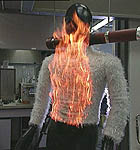10th Science-Apéro
How dangerous are burning clothes?
"When the skirt is on fire – how much can clothing withstand?" A presentation with this title was given by specialists from the Swiss Council for Accident Prevention (bfu), Swiss Federal Laboratories for Materials Testing and Research (EMPA) and Swiss Federal Office of Public Health (BAG), in the latest "Science-Apéro" organized by the EMPA Academy.

|
"Clothes make the man", as Gottfried Keller said. Which is probably why when people buy clothing today, they place so much value on up-to-date colours, fashionable styles, the right designer label and high-quality materials. And no one wants to have to bother dry-cleaning things, so easy care textiles are also a must. The one point, however, that is hardly ever taken into account when buying clothing is the flammability of the article in question. |
||||
|
||||
|
Clothes can be dangerous As a rule, apart from firefighters, no-one is really interested in the fire resistance of a textile. According to Martin Hugi of the bfu, although clothing fires represent only a small fraction of all accidents, when they do occur the consequences are very serious for those involved. On average about 400 cases of clothing fires necessitating medical care occur in Switzerland annually, of which up to five result in fatalities. It is not difficult to set fire to clothing – all it takes is a moment of inattention and a loose blouse catches fire over the gas stove, a T-shirt too near to the barbecue goes up in flames or a towelling dressing gown brushes against a candle and a surface flash occurs. But even if the prime cause of such accidents is lack of caution, improper handling of fire, or simple thoughtlessness, clothing must also offer adequate security. For this reason, the bfu requires strict adherence to the maximum flame-spreading speed of 90 mm per second as laid down in the Flammability Regulations. In addition, the bfu notes with dismay the lack of information in this regard provided with clothing. Manufacturers, importers and resellers must take their responsibilities more seriously, according to Martin Hugi. |
||||
|
Henry the Articulated Dummy goes through fire on our behalf Next René Rossi of the EMPA presented the results of a recently completed study, in which the practical application of the requirements of the Flammability Regulations relevant to textiles were investigated. One controversial question was whether light materials with very rapid flame-spreading characteristics were at all capable of producing significant burns to the skin. Did they just burn away so fast that there was no time for any dangerous level of heat transfer to the skin to occur? Changes to the flammability of clothing materials due to wear, washing and tumble-drying, or climatic effects were also investigated. During the experiments, Henry the Articulated Dummy, suitably equipped with temperature sensors, played the victim and risked his "skin" for a good cause. Measurements showed quite clearly that any contact of the skin with a naked flame results in burn injuries, thus offering no support to the theory that light materials made of cellulose combust so quickly that they do not cause skin burns. The flame-spreading speed, as laid down in the Flammability Regulations, does however seem to be a good parameter by which to judge the safety of clothing made of natural fibres. This means that light materials whose flame-spreading speed exceeds the maximum allowed value should either be withdrawn from sale or treated with fire retardants. Results of other tests with Henry also showed, however, that textile consisting of a mixture with a relatively high proportion of cellulose fibre combined with synthetic fibres, which melt on combustion, can under certain circumstances represent an even higher fire-risk to the wearer. With this type of material it is necessary to take into account heat transfer characteristics to evaluate the potential danger. Heat transfer is not, however, a parameter which is taken into account in the Flammability Regulations. |
||||
|
The pros and cons of flame-retardants Eva Reinhard, a biologist from the BAG, next spoke about the use of flame-retardants. These chemicals find their way into many different areas of our daily life, for example in electrical and electronic devices, upholstered furniture, paints, and – very widely – in textiles. Many of these compounds have not been adequately tested from the toxicological point of view, and are suspected of causing long-term health problems. Absorption through the skin and lungs, and through the placenta in prenatal infants, plays a decisive role here. In general, any exposure to toxic substances is to be avoided. However, with flame-retardants a risk evaluation must be made to ensure that the danger of suffering severe burn injuries through not using these substances is greater than the possible health problems their usage may create. At the same time, according to Eva Reinhard, the sum of all the risks involved should be minimized as far as possible. |
||||
|
A heated discussion After the talks ended, a heated discussion ensued between the speakers and the audience. A representative of the textile industry expressed the fear that if the requirements of the Flammability Regulations were strictly imposed, many materials could no longer be sold in Switzerland or exported. Another member of the audience pointed out the negative effects of increased safety standards on the imports of eco-textiles from developing nations. These comments elicited a pointed response from bfu-representative Martin Hugi – in his opinion it was absolutely wrong to place economic interests above personal safety. He was convinced, he said, that the textile industry was capable of simultaneously meeting the requirements of the Flammability Regulations and manufacturing attractive textile materials. This could be achieved through greater research and development efforts, in which process the EMPA would very willingly take part. |
||||
|
|
||||

